 Welcome to 2013 and the beginning of a new reading year. The Children’s Literature and Reading Special Interest Group of the International Reading Association wishes everyone a Happy New Reading Year and would like to begin the year with some new reading possibilities for students and teachers. So many organizations listed their best and/or favorite books of the year and 2012 certainly had a wonderful crop of new titles. The list below reflects some of the later releases in 2012 titles but we also begin discussing some of the new titles coming out for the 2013 publishing year. Thanks to all the publishers who sent books for review to get the New Year launched! Over the next several weeks we will be honoring the 75th anniversary of the Randolph Caldecott Award so watch for Caldecott connections in the reviews.
Welcome to 2013 and the beginning of a new reading year. The Children’s Literature and Reading Special Interest Group of the International Reading Association wishes everyone a Happy New Reading Year and would like to begin the year with some new reading possibilities for students and teachers. So many organizations listed their best and/or favorite books of the year and 2012 certainly had a wonderful crop of new titles. The list below reflects some of the later releases in 2012 titles but we also begin discussing some of the new titles coming out for the 2013 publishing year. Thanks to all the publishers who sent books for review to get the New Year launched! Over the next several weeks we will be honoring the 75th anniversary of the Randolph Caldecott Award so watch for Caldecott connections in the reviews.
GRADES K-3
Beake, Lesley. (2012). Little lion. Illus. by Erika Pal. London, UK: Frances Lincoln Children’s Books.
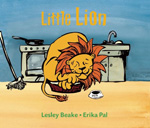 One bright sunny day, Dad brings home a pet that uncle has given him and says it is a dog. Mum, twin brothers Bob and the narrator of the story, look at the animal and can clearly see it is a lion! For months, the “dog”, now simply called Dog, gets accustomed to living in the house and truly becomes the family pet. However, Dog is growing and growing into a fully-grown lion with roars and scratches and big animal needs. Mum has slowly accepted Dog and gotten used to having him around and tells the boys they need to get him outside for regular exercise. The boys are afraid to take him around the neighborhood so they keep him in the garden and backyard. The school bully, Big Jonno, starts asking questions about the roars he hears coming from their house but the brothers continue to keep Dog out of sight. One inevitable day the lion escapes and Bob and his brother find him on top of Jonno who is terrified! They slowly manage to get their lion off Jonno, lingering just a bit to make sure Jonno won’t mess with them again. Retold from a South African tale, “Little Lion” makes a fun companion to 1953 Caldecott winner “The Biggest Bear” by Lynd Ward to compare what happens when wild animals become pets that are too big for a home. Use ReadWriteThink’s lesson idea for creating two Venn Diagrams to introduce the concept of comparison.
One bright sunny day, Dad brings home a pet that uncle has given him and says it is a dog. Mum, twin brothers Bob and the narrator of the story, look at the animal and can clearly see it is a lion! For months, the “dog”, now simply called Dog, gets accustomed to living in the house and truly becomes the family pet. However, Dog is growing and growing into a fully-grown lion with roars and scratches and big animal needs. Mum has slowly accepted Dog and gotten used to having him around and tells the boys they need to get him outside for regular exercise. The boys are afraid to take him around the neighborhood so they keep him in the garden and backyard. The school bully, Big Jonno, starts asking questions about the roars he hears coming from their house but the brothers continue to keep Dog out of sight. One inevitable day the lion escapes and Bob and his brother find him on top of Jonno who is terrified! They slowly manage to get their lion off Jonno, lingering just a bit to make sure Jonno won’t mess with them again. Retold from a South African tale, “Little Lion” makes a fun companion to 1953 Caldecott winner “The Biggest Bear” by Lynd Ward to compare what happens when wild animals become pets that are too big for a home. Use ReadWriteThink’s lesson idea for creating two Venn Diagrams to introduce the concept of comparison.
- Karen Hildebrand, Ohio Library and Reading Consultant
Marasli, Armen and Aida. (2012). Winds; a legend from the Lower Yukon. (retold). Illus. by Zepur Hanimyan. Agoura Hills, CA: World Legends for Kids.
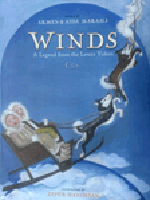 A folktale from the lower Yukon region of Canada begins the new series from the publisher “… designed to introduce children to cultures around the world through pictures and traditional stories.” The story opens describing a time long ago when the Earth was young and there was no wind; no fierce storms, no gentle breezes. Along the Yukon River lived a couple that desperately wanted a child. Years went by and they remained childless. One night, a dream came to the wife telling her to make a blanket with bird feathers and so she did. On another occasion in a dream, a sled pulled by three dogs and an old driver appeared in her dreams. The driver took her on a dream journey to show her a solitary tree and told her she needed to make a doll from the trunk of this tree to bring her good fortune. When she awoke, she insisted her husband find that tree which he did. She then made the doll as instructed in her dream and placed it on a pillow by her bed. The next day the doll had become a little boy. As the young boy learns the village and ways of his people, he ventures to the edge of the world and sees four holes in the sky, each covered by a piece of animal skin. Being curious, he uses his spear to cut a slash through the skins. As the holes open warm airs pushes through in addition to birds and animals and he calls this Wind and says, “Wind, sometimes blow hard, sometimes soft, and sometimes not at all.” (p.26) As he continues to open each of the four holes, different seasonal winds and animals push through. And so, the young boy brought wind to the Earth. In celebrating the anniversary of the Caldecott Award this year, read this Yup’ik story along with Gerald McDermott’s 1975 Caldecott “Arrow to the Sun,” Paul Goble’s 1979 winner, “The Girl Who Loved Wild Horses,” or 1976 winner “Why Mosquitoes Buzz in People’s Ears” (Leo and Diane Dillon, Verna Aardema) to compare native people stories. Watch for more at the publisher’s website.
A folktale from the lower Yukon region of Canada begins the new series from the publisher “… designed to introduce children to cultures around the world through pictures and traditional stories.” The story opens describing a time long ago when the Earth was young and there was no wind; no fierce storms, no gentle breezes. Along the Yukon River lived a couple that desperately wanted a child. Years went by and they remained childless. One night, a dream came to the wife telling her to make a blanket with bird feathers and so she did. On another occasion in a dream, a sled pulled by three dogs and an old driver appeared in her dreams. The driver took her on a dream journey to show her a solitary tree and told her she needed to make a doll from the trunk of this tree to bring her good fortune. When she awoke, she insisted her husband find that tree which he did. She then made the doll as instructed in her dream and placed it on a pillow by her bed. The next day the doll had become a little boy. As the young boy learns the village and ways of his people, he ventures to the edge of the world and sees four holes in the sky, each covered by a piece of animal skin. Being curious, he uses his spear to cut a slash through the skins. As the holes open warm airs pushes through in addition to birds and animals and he calls this Wind and says, “Wind, sometimes blow hard, sometimes soft, and sometimes not at all.” (p.26) As he continues to open each of the four holes, different seasonal winds and animals push through. And so, the young boy brought wind to the Earth. In celebrating the anniversary of the Caldecott Award this year, read this Yup’ik story along with Gerald McDermott’s 1975 Caldecott “Arrow to the Sun,” Paul Goble’s 1979 winner, “The Girl Who Loved Wild Horses,” or 1976 winner “Why Mosquitoes Buzz in People’s Ears” (Leo and Diane Dillon, Verna Aardema) to compare native people stories. Watch for more at the publisher’s website.
- Karen Hildebrand, Ohio Library and Reading Consultant
Seven, John. (2012). A year with friends. Illus. by Jana Christy. New York: Abrams Appleseed.
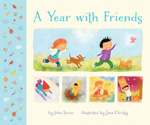 This beautiful new picture book will be a great way to start the New Year in classrooms with young readers. Illustrated with soft shades and panels across double page spreads, the story line alternates between a young girl and a young boy having fun each month of the year. In August, they meet each other for the first time at the beach and build a sand castle together. Each double page thereafter shows the two friends together. Each month of the year offers a writing pattern “January is time for rolling down hills,” “April is time to get messy,” “August is time for the beach,” and concludes with “A new year is time for fun with new friends.” Primary teachers and school librarians will find a multitude of ways to use this book in classrooms and libraries. Learn more on the husband and wife author/illustrator team's website. ReadWriteThink offers a lesson plan on cycles and circular plot structures. Read aloud the 1965 Caldecott winner, May I Bring a Friend? (Beatrice Schenk de Regniers, Beni Montresor) to continue the theme of friends.
This beautiful new picture book will be a great way to start the New Year in classrooms with young readers. Illustrated with soft shades and panels across double page spreads, the story line alternates between a young girl and a young boy having fun each month of the year. In August, they meet each other for the first time at the beach and build a sand castle together. Each double page thereafter shows the two friends together. Each month of the year offers a writing pattern “January is time for rolling down hills,” “April is time to get messy,” “August is time for the beach,” and concludes with “A new year is time for fun with new friends.” Primary teachers and school librarians will find a multitude of ways to use this book in classrooms and libraries. Learn more on the husband and wife author/illustrator team's website. ReadWriteThink offers a lesson plan on cycles and circular plot structures. Read aloud the 1965 Caldecott winner, May I Bring a Friend? (Beatrice Schenk de Regniers, Beni Montresor) to continue the theme of friends.
- Karen Hildebrand, Ohio Library and Reading Consultant
GRADES 3-5
Rau, Dana Meachen. (2013). Dessert designer; creations you can make and eat! Mankato, MN: Capstone Press.
 The cover of this book alone invites creativity ensured to result in a tasty bite – just in time for Valentine’s Day treats. The contents are divided into chapters on cupcakes, cookies, candies and cakes. Opening with ideas for decorators and an itemized photograph for the decorator’s toolkit, photographs of beautifully decorated delectable desserts with step-by-step recipes await! Though most of these decorated beauties require an adult hand, there are a few that children could manage with adult help. The sidebar tips and ideas are especially helpful for those masters of the kitchen who like to expand on an idea. ReadWriteThink offers a lesson plan to have children write recipes that will make a suitable companion for this book. Bon appétit! A fresh start right from the oven.
The cover of this book alone invites creativity ensured to result in a tasty bite – just in time for Valentine’s Day treats. The contents are divided into chapters on cupcakes, cookies, candies and cakes. Opening with ideas for decorators and an itemized photograph for the decorator’s toolkit, photographs of beautifully decorated delectable desserts with step-by-step recipes await! Though most of these decorated beauties require an adult hand, there are a few that children could manage with adult help. The sidebar tips and ideas are especially helpful for those masters of the kitchen who like to expand on an idea. ReadWriteThink offers a lesson plan to have children write recipes that will make a suitable companion for this book. Bon appétit! A fresh start right from the oven.
- Karen Hildebrand, Ohio Library and Reading Consultant
GRADES 5 - 8
Bausum, Ann. (2013). Our country’s presidents. Foreword by President Barack Obama. Washington, D.C.: National Geographic.
 As the nation begins a fresh start with the next term of the President, National Geographic has released this book in time for the Inauguration of the President of the United States on Jan. 20 and 21 for President Barack Obama, 44th President of the United States. Each section opens with a full-page portrait of the president with biographical information to follow. Quick fact boxes open each section as well and historic paintings, reproductions, newspaper articles and photographs complement each article. The articles are grouped into eras with representative timelines including: The Presidency and How it Grew, 1789-1837; From Sea to Shining Sea, 1837-1861; A New Birth of Freedom, 1861-1897; America Takes Center Stage, 1897-1933; Seeking Stability in the Atomic Age, 1933-1981; Footprints on the Global Frontier, 1981-Present. A comprehensive index, resource guide, and a chart of presidential election results are found at the end of the book. This book is the revised and updated edition from 2005 by author Ann Bausum. The publisher refers to this volume as “… the definitive family reference guide to the fascinating lives of our leaders past and present.” Learn more about the upcoming inauguration and the history of the ceremony.
As the nation begins a fresh start with the next term of the President, National Geographic has released this book in time for the Inauguration of the President of the United States on Jan. 20 and 21 for President Barack Obama, 44th President of the United States. Each section opens with a full-page portrait of the president with biographical information to follow. Quick fact boxes open each section as well and historic paintings, reproductions, newspaper articles and photographs complement each article. The articles are grouped into eras with representative timelines including: The Presidency and How it Grew, 1789-1837; From Sea to Shining Sea, 1837-1861; A New Birth of Freedom, 1861-1897; America Takes Center Stage, 1897-1933; Seeking Stability in the Atomic Age, 1933-1981; Footprints on the Global Frontier, 1981-Present. A comprehensive index, resource guide, and a chart of presidential election results are found at the end of the book. This book is the revised and updated edition from 2005 by author Ann Bausum. The publisher refers to this volume as “… the definitive family reference guide to the fascinating lives of our leaders past and present.” Learn more about the upcoming inauguration and the history of the ceremony.
- Karen Hildebrand, Ohio Library and Reading Consultant
Fleming, Candace. (2012). On the day I died: Stories from the grave. New York: Random House/Schwartz & Wade.
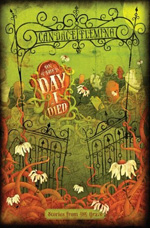 In this delightfully creepy book, nine different ghosts describe in ghastly fashion what happened on the day they died. The fear factor is heightened by the fact that the stories are being told in a cemetery and all of the deaths occurred in or near Chicago. Teen Mike Kowalski listens empathetically as the stories seem to grow sadder and more horrifying. Upon their conclusion, he realizes just how close he came to being one of them. One of the most appealing aspects of this collection is how the author draws from familiar suspense stories for inspiration. For instance, her story “Lily” describes what happens to that cursed paw from the original story "The Monkey's Paw." She chillingly combines elements of Edgar Allan Poe's "Berenice" and Charlotte Perkins Gilman's "The Yellow Wallpaper" in her story "Edgar." A perfect read aloud on a dark and lonely night or during a slumber party, this collection is likely to prompt readers to slow down, make a fresh start and appreciate the days that lie ahead, just as Mike learns to do. Readers won't want to skip the back matter in which the author explains the inspiration for each of the short stories.
In this delightfully creepy book, nine different ghosts describe in ghastly fashion what happened on the day they died. The fear factor is heightened by the fact that the stories are being told in a cemetery and all of the deaths occurred in or near Chicago. Teen Mike Kowalski listens empathetically as the stories seem to grow sadder and more horrifying. Upon their conclusion, he realizes just how close he came to being one of them. One of the most appealing aspects of this collection is how the author draws from familiar suspense stories for inspiration. For instance, her story “Lily” describes what happens to that cursed paw from the original story "The Monkey's Paw." She chillingly combines elements of Edgar Allan Poe's "Berenice" and Charlotte Perkins Gilman's "The Yellow Wallpaper" in her story "Edgar." A perfect read aloud on a dark and lonely night or during a slumber party, this collection is likely to prompt readers to slow down, make a fresh start and appreciate the days that lie ahead, just as Mike learns to do. Readers won't want to skip the back matter in which the author explains the inspiration for each of the short stories.
- Barbara A. Ward, Washington State University Pullman
GRADES 9-12
Avery, Lara. (2012). Anything but ordinary. New York: Hyperion.
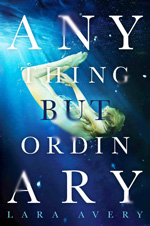 Bryce Graham, now age 22, is coming out of a five-year coma, and has to start a new life. Bryce hoped for a shot at the Olympics when an error in judgment during her dive at the Olympic trials left her hospitalized for five years. On the brink of giving up hope, her parents are ecstatic that Bryce has returned, but Bryce discovers that the five years missing from her life have left a gap she has to work through and decide about her new steps forward. Miraculously, her recovery moves very quickly. Her doctors are concerned at how quickly this miraculous comeback is taking place. Many things have changed, however, and life has certainly moved ahead while Bryce was in the hospital. Her parents seem to be struggling with their marriage. Her once sweet little sister, Sydney, has become a goth and bitter wild teen. Her best friend and boyfriend, now graduated from college are also now engaged … to each other! As Bryce tries to sort out all these new scenarios and find her place in the contemporary world, questions and decisions abound. Carter, the young hospital intern has been at her side from the beginning as Bryce discovers. As her recovery seems to keep moving at an incredible pace, her decisions about what is next for her take an unexpected turn. Read more at the author's website.
Bryce Graham, now age 22, is coming out of a five-year coma, and has to start a new life. Bryce hoped for a shot at the Olympics when an error in judgment during her dive at the Olympic trials left her hospitalized for five years. On the brink of giving up hope, her parents are ecstatic that Bryce has returned, but Bryce discovers that the five years missing from her life have left a gap she has to work through and decide about her new steps forward. Miraculously, her recovery moves very quickly. Her doctors are concerned at how quickly this miraculous comeback is taking place. Many things have changed, however, and life has certainly moved ahead while Bryce was in the hospital. Her parents seem to be struggling with their marriage. Her once sweet little sister, Sydney, has become a goth and bitter wild teen. Her best friend and boyfriend, now graduated from college are also now engaged … to each other! As Bryce tries to sort out all these new scenarios and find her place in the contemporary world, questions and decisions abound. Carter, the young hospital intern has been at her side from the beginning as Bryce discovers. As her recovery seems to keep moving at an incredible pace, her decisions about what is next for her take an unexpected turn. Read more at the author's website.
- Karen Hildebrand, Ohio Library and Reading Consultant
Blumenthal, Karen. (2012). Steve Jobs: The man who thought different. New York: Macmillan/Feiwel & Friends.
 This biography about Steve Jobs describes the deep contradictions within the man who changed the music, film, and communications industry. The life story of the man who became the face of Apple is framed around a 2005 commencement speech he gave at Stanford. It’s interesting to note that Jobs himself never earned a college degree. The author weaves in personal and anecdotal information around the three stories Jobs related to the graduates at that ceremony, allowing readers to decide for themselves how they feel about the man. As successful as Jobs was in his business efforts, he also experienced failures, sometimes very public failures, and had to overcome challenges. It's never quite clear--other than his having been adopted--what formed his unique personality and drive to succeed and to control so many aspects of the company he was trying to run. Readers may shake their heads as he seems to deny that he has cancer or even possibly wonder about the ethics of a company keeping the health of one of its top officials a secret. Nevertheless, Job’s philosophical reminder not to waste the limited time each of us has is an excellent thought for the start of a new year. Teen readers will enjoy reading this title and trying to tease out this man's motivations and understand his personality while smiling at the black and white photographs of the young Jobs.
This biography about Steve Jobs describes the deep contradictions within the man who changed the music, film, and communications industry. The life story of the man who became the face of Apple is framed around a 2005 commencement speech he gave at Stanford. It’s interesting to note that Jobs himself never earned a college degree. The author weaves in personal and anecdotal information around the three stories Jobs related to the graduates at that ceremony, allowing readers to decide for themselves how they feel about the man. As successful as Jobs was in his business efforts, he also experienced failures, sometimes very public failures, and had to overcome challenges. It's never quite clear--other than his having been adopted--what formed his unique personality and drive to succeed and to control so many aspects of the company he was trying to run. Readers may shake their heads as he seems to deny that he has cancer or even possibly wonder about the ethics of a company keeping the health of one of its top officials a secret. Nevertheless, Job’s philosophical reminder not to waste the limited time each of us has is an excellent thought for the start of a new year. Teen readers will enjoy reading this title and trying to tease out this man's motivations and understand his personality while smiling at the black and white photographs of the young Jobs.
- Barbara A. Ward, Washington State University Pullman
Condie, Ally. (2012). Reached. New York: Penguin/Dutton Children’s Books.
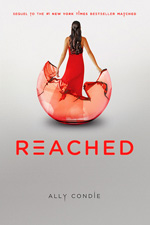 In the satisfying final installment of the Matched series, Cassia, Ky, and Xander are all busily working to create a better world, each in their own way. Since the story is told through each of their eyes, readers are able to understand each of the three main characters’ motivations and feelings. The author does a splendid job of showing how the two sides to the conflict, the Society and the Rising, start to resemble each other more as this book moves to its conclusion. In the first book, the Society seems so all controlling and evil, but now readers will notice that neither side is without blame. The rebellion of the Rising and its leaders has been so infiltrated by Society members and vice versa that it becomes hard to sort the good folks from the bad ones. Maybe in the end, there is little point to generalizing groups of individuals. Teen readers will enjoy thinking about several ethics questions at the heart of this novel, and some will even savor the poetic language with which the author tells this story of survival, determination, and ultimately, hope. The author's decision to circle back again to a few important events in the first book adds to this one's power and shows the characters’ growth. The ruminations about how easy it is to fall in love the first time since you don't know about the possible heartaches and losses and how brave it is to try to love again are particularly apt and worthy of much consideration. By the time the end of the novel has been reached, its main characters have that fresh start they dreamed about, even if things don’t turn out quite the way they envisioned.
In the satisfying final installment of the Matched series, Cassia, Ky, and Xander are all busily working to create a better world, each in their own way. Since the story is told through each of their eyes, readers are able to understand each of the three main characters’ motivations and feelings. The author does a splendid job of showing how the two sides to the conflict, the Society and the Rising, start to resemble each other more as this book moves to its conclusion. In the first book, the Society seems so all controlling and evil, but now readers will notice that neither side is without blame. The rebellion of the Rising and its leaders has been so infiltrated by Society members and vice versa that it becomes hard to sort the good folks from the bad ones. Maybe in the end, there is little point to generalizing groups of individuals. Teen readers will enjoy thinking about several ethics questions at the heart of this novel, and some will even savor the poetic language with which the author tells this story of survival, determination, and ultimately, hope. The author's decision to circle back again to a few important events in the first book adds to this one's power and shows the characters’ growth. The ruminations about how easy it is to fall in love the first time since you don't know about the possible heartaches and losses and how brave it is to try to love again are particularly apt and worthy of much consideration. By the time the end of the novel has been reached, its main characters have that fresh start they dreamed about, even if things don’t turn out quite the way they envisioned.
- Barbara A. Ward, Washington State University Pullman
Hesse, Karen. (2012). Safekeeping. New York: Macmillan/Feiwel & Friends.
 Discord erupts in the United States after the American People’s Party assumes power while teen Radley Parker-Hughes is volunteering in an orphanage in Haiti. She returns home to restrictions on travel from one state to another and an empty house. She decides to walk from New Hampshire to Vermont, and when her parents are nowhere to be found, she heads north to Canada where she hopes to find sanctuary. Along the way she meets another traveler, Celia, and together, they fashion a makeshift home in an abandoned schoolhouse. As Radley travels, she must be wary of others and the risk of being caught and jailed. Overheard conversations and newspaper snippets describing the riots and illnesses in the overcrowded prison systems are her source of information about her homeland. The fact that she is traveling through fairly sparsely inhabited areas also adds to her limited perspective on national events. The inclusion of several black and white photographs (taken by the author) alongside the text oftentimes reflects Radley's mood while also representing her photographer mother's keen visual eye. A child of privilege, the introspective Radley reminds herself of the many times her parents have helped her out of messes she has made, something she wishes they could do now. In the end, though, the book's power and impact can be summed up through the words of Madame Seville, a kindly Canadian who has befriended Radley: “‘As long as you live, it is never too late to make amends. Take my advice, child. Don't waste your precious life with regrets and sorrow. Find a way to make right what was wrong, and then move on’” (p. 277). What perfect words to follow for the rest of our lives! Enjoy more from Hesse in the Engage post "In Other Words: Karen Hesse (SAFEKEEPING) Writes the Future."
Discord erupts in the United States after the American People’s Party assumes power while teen Radley Parker-Hughes is volunteering in an orphanage in Haiti. She returns home to restrictions on travel from one state to another and an empty house. She decides to walk from New Hampshire to Vermont, and when her parents are nowhere to be found, she heads north to Canada where she hopes to find sanctuary. Along the way she meets another traveler, Celia, and together, they fashion a makeshift home in an abandoned schoolhouse. As Radley travels, she must be wary of others and the risk of being caught and jailed. Overheard conversations and newspaper snippets describing the riots and illnesses in the overcrowded prison systems are her source of information about her homeland. The fact that she is traveling through fairly sparsely inhabited areas also adds to her limited perspective on national events. The inclusion of several black and white photographs (taken by the author) alongside the text oftentimes reflects Radley's mood while also representing her photographer mother's keen visual eye. A child of privilege, the introspective Radley reminds herself of the many times her parents have helped her out of messes she has made, something she wishes they could do now. In the end, though, the book's power and impact can be summed up through the words of Madame Seville, a kindly Canadian who has befriended Radley: “‘As long as you live, it is never too late to make amends. Take my advice, child. Don't waste your precious life with regrets and sorrow. Find a way to make right what was wrong, and then move on’” (p. 277). What perfect words to follow for the rest of our lives! Enjoy more from Hesse in the Engage post "In Other Words: Karen Hesse (SAFEKEEPING) Writes the Future."
- Barbara A. Ward, Washington State University Pullman
Hoose, Phillip M. (2012). Moonbird: A year on the wind with the great survivor B95. New York: Farrar, Straus and Giroux.
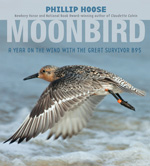 This amazing nonfiction title describes a feat that is stranger than many fiction stories. In eight engaging chapters, Phillip Hoose makes readers care about the most unlikely of winged heroes, the rufa red knot, known as B95 because of its band number, and affectionately called the Moonbird because the distance he has flown during his lifetime equals a trip to the moon and halfway back. Each year this amazing bird flies from Tierra del Fuego near the bottom of the Earth to San Antonio Bay and then to Delaware Bay where it gorges before heading further north to Southampton Island. There it mates, breeds, and eats before flying south once again. The bird was first banded in 1995, and scientists think he is around 20 years old. Each year, when scientists band and count red knots, they look for him since he has become a symbol of survival and persistence, and his existence represents an amazing feat. This tiny bird has survived predators, long, tiring flights, and threats from various viruses as well as dwindling food sources, thanks to constant human encroaching on his feeding grounds. As he does with every topic he tackles--the ivory-billed woodpecker, civil rights, basketball--Hoose provides interesting details about his topic, and then, provides ways that they can act to make a change. Additionally, the thumbnail sketches of scientists and youngsters who are involved in making sure there is a place for B95 and others of his species answer any questions readers might have as they are reading. Above all, this is a survival story nestled within a story of conservation, one that reminds readers of the interconnection of species. There are several photographs and maps that help readers understand exactly how far this bird has flown and how unlikely his survival really is. Given the odds against him, how can we not care about the fate of B95 and others like him? Nonfiction doesn’t get better than this.
This amazing nonfiction title describes a feat that is stranger than many fiction stories. In eight engaging chapters, Phillip Hoose makes readers care about the most unlikely of winged heroes, the rufa red knot, known as B95 because of its band number, and affectionately called the Moonbird because the distance he has flown during his lifetime equals a trip to the moon and halfway back. Each year this amazing bird flies from Tierra del Fuego near the bottom of the Earth to San Antonio Bay and then to Delaware Bay where it gorges before heading further north to Southampton Island. There it mates, breeds, and eats before flying south once again. The bird was first banded in 1995, and scientists think he is around 20 years old. Each year, when scientists band and count red knots, they look for him since he has become a symbol of survival and persistence, and his existence represents an amazing feat. This tiny bird has survived predators, long, tiring flights, and threats from various viruses as well as dwindling food sources, thanks to constant human encroaching on his feeding grounds. As he does with every topic he tackles--the ivory-billed woodpecker, civil rights, basketball--Hoose provides interesting details about his topic, and then, provides ways that they can act to make a change. Additionally, the thumbnail sketches of scientists and youngsters who are involved in making sure there is a place for B95 and others of his species answer any questions readers might have as they are reading. Above all, this is a survival story nestled within a story of conservation, one that reminds readers of the interconnection of species. There are several photographs and maps that help readers understand exactly how far this bird has flown and how unlikely his survival really is. Given the odds against him, how can we not care about the fate of B95 and others like him? Nonfiction doesn’t get better than this.
- Barbara A. Ward, Washington State University Pullman
Howard, A. G. (2013). Splintered. New York: Abrams/Amulet Books.
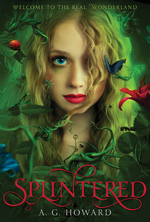 Alyssa Gardner is not the typical teen. Able to hear the thoughts of insects and plants, she fears being hospitalized just like her mother if she admits to those delusions. But are they delusions? Her father has finally given permission for shock treatment to help her mother get better, a decision that Alyssa does not support. In order to find out the truth about her mother, she steps through a mirror and into a completely alien world on the night of the prom. She is lured there by Morpheus, a figure she remembers from her childhood. As she makes her way through this strange place, she realizes that some of it seems familiar and yet is twisted slightly. It seems that Alyssa is inextricably linked with her ancestor, the original Alice from the Lewis Carroll stories. Accompanied by Jed, the handsome boy next door, Alyssa must undo all the havoc caused by the original Alice when she went through that famous rabbit hole long ago. All the tasks set before her are challenging, and she must find inner strength to complete them. Along the way, she becomes a pawn in the middle of an insane political battle between opposing sides, neither of which can be trusted. The author builds a credible world, by turns alluring and in the next second, frightening or horrifying, through which Jed and Alyssa. While readers will find it helpful to have read Lewis Carroll's works, including “Jabberwocky,” this title is engaging enough on its own to hold their interest or to prompt a peek into the original Alice’s Adventures in Wonderland, written in 1865. Wonderland is filled with much that is not as wonderful as might be expected, and yet, it is in Wonderland that Alyssa accepts her true nature. The cover with its swirling tendrils and insects surrounding Alyssa will surely attract teen readers who will not disappointed with this magical, edgy tale.
Alyssa Gardner is not the typical teen. Able to hear the thoughts of insects and plants, she fears being hospitalized just like her mother if she admits to those delusions. But are they delusions? Her father has finally given permission for shock treatment to help her mother get better, a decision that Alyssa does not support. In order to find out the truth about her mother, she steps through a mirror and into a completely alien world on the night of the prom. She is lured there by Morpheus, a figure she remembers from her childhood. As she makes her way through this strange place, she realizes that some of it seems familiar and yet is twisted slightly. It seems that Alyssa is inextricably linked with her ancestor, the original Alice from the Lewis Carroll stories. Accompanied by Jed, the handsome boy next door, Alyssa must undo all the havoc caused by the original Alice when she went through that famous rabbit hole long ago. All the tasks set before her are challenging, and she must find inner strength to complete them. Along the way, she becomes a pawn in the middle of an insane political battle between opposing sides, neither of which can be trusted. The author builds a credible world, by turns alluring and in the next second, frightening or horrifying, through which Jed and Alyssa. While readers will find it helpful to have read Lewis Carroll's works, including “Jabberwocky,” this title is engaging enough on its own to hold their interest or to prompt a peek into the original Alice’s Adventures in Wonderland, written in 1865. Wonderland is filled with much that is not as wonderful as might be expected, and yet, it is in Wonderland that Alyssa accepts her true nature. The cover with its swirling tendrils and insects surrounding Alyssa will surely attract teen readers who will not disappointed with this magical, edgy tale.
- Barbara A. Ward, Washington State University Pullman
Marsh, Katherine. (2012). Jepp, who defied the stars. New York: Hyperion.
 Edgar-Award winning author Katherine Marsh has blended a footnote from history into an intriguing story set in the 16th century about the life of Jepp, a dwarf born in Brussels. Raised in a country inn by a loving mother and the people who frequent the inn, Jepp is one day offered a life at court by an impressive traveler. Thinking it is the best for Jepp’s future, he sets off with this courtier to begin a new life with the Spanish Infanta. However, life at court is not as he imagined as he is placed with other dwarves as part of the court “collection” of oddities used for the entertainment of the queen. Jepp is not only disappointed but also humiliated and plots his escape. The narration of the story is deftly told through Jepp’s voice, especially when his escape plot is foiled and he is imprisoned in a cage and deported to his new life as the court dwarf for astronomer Tyche Brache on his island castle Coudenberg in Denmark. Jepp’s life takes a dramatic turn as he becomes accustomed to this new scientific atmosphere in which he discovers an affinity for astronomy that offers a whole new factual look at the stars. An important thread throughout the story is the question of Jepp’s father’s identity. Gnawing at him always, this question leads him to search for the answer taking him back to Brussels in search of answers. Steeped in historical and unusual facts, this is a most unusual but fascinating adventure. This book is a 2012 NY Times Notable Children’s Book and The Wall Street Journal Best Children’s Books of 2012. Read more about the author and view some background videos of the period on Katherine Marsh’s website, and see her "In Other Words: On a Writer's Journey, Finding a Fellow Traveler" post on the Engage blog.
Edgar-Award winning author Katherine Marsh has blended a footnote from history into an intriguing story set in the 16th century about the life of Jepp, a dwarf born in Brussels. Raised in a country inn by a loving mother and the people who frequent the inn, Jepp is one day offered a life at court by an impressive traveler. Thinking it is the best for Jepp’s future, he sets off with this courtier to begin a new life with the Spanish Infanta. However, life at court is not as he imagined as he is placed with other dwarves as part of the court “collection” of oddities used for the entertainment of the queen. Jepp is not only disappointed but also humiliated and plots his escape. The narration of the story is deftly told through Jepp’s voice, especially when his escape plot is foiled and he is imprisoned in a cage and deported to his new life as the court dwarf for astronomer Tyche Brache on his island castle Coudenberg in Denmark. Jepp’s life takes a dramatic turn as he becomes accustomed to this new scientific atmosphere in which he discovers an affinity for astronomy that offers a whole new factual look at the stars. An important thread throughout the story is the question of Jepp’s father’s identity. Gnawing at him always, this question leads him to search for the answer taking him back to Brussels in search of answers. Steeped in historical and unusual facts, this is a most unusual but fascinating adventure. This book is a 2012 NY Times Notable Children’s Book and The Wall Street Journal Best Children’s Books of 2012. Read more about the author and view some background videos of the period on Katherine Marsh’s website, and see her "In Other Words: On a Writer's Journey, Finding a Fellow Traveler" post on the Engage blog.
- Karen Hildebrand, Ohio Library and Reading Consultant
Meyer, Marissa. (2013). Scarlet: The Lunar Chronicles. New York: Macmillan/Feiwel and Friends.
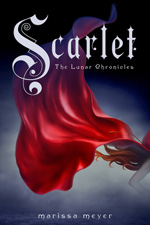 Who thinks of combining fairy tales and science fiction? Well, not only does Marissa Meyer do exactly that in the first installment of The Lunar Chronicles when she creates a Cinderella-like character that happens to be a cyborg, but also she does it very well. In the second title in this saga, she introduces Scarlet Benoit, who lives in the rural part of France where she grows vegetables with her grandmother. Scarlet has red hair and usually wears a red hoodie, and is determined to find her missing grandmother. When she happens to meet a fierce street fighter named Wolf with a strange tattoo, she suspects him of having something to do with her grandmother’s disappearance and then hopes he can offer some clues about her whereabouts. Despite her misgivings, she decides to trust him, and they set off for Paris. Meanwhile, Linh Cinder manages to escape from prison and look for links to her past. Readers will turn the book's pages as fast as they can to find out how the paths of these two strong female characters come together, to reveal the link between Scarlet’s grandmother and Cinder and to see how long Emperor Kai can keep the treacherous Queen Levana at bay. The title is filled with twists and turns as well as romantic possibilities, leaving readers desperate for the next two titles. In her own way, Scarlet is just as interesting as Cinder.
Who thinks of combining fairy tales and science fiction? Well, not only does Marissa Meyer do exactly that in the first installment of The Lunar Chronicles when she creates a Cinderella-like character that happens to be a cyborg, but also she does it very well. In the second title in this saga, she introduces Scarlet Benoit, who lives in the rural part of France where she grows vegetables with her grandmother. Scarlet has red hair and usually wears a red hoodie, and is determined to find her missing grandmother. When she happens to meet a fierce street fighter named Wolf with a strange tattoo, she suspects him of having something to do with her grandmother’s disappearance and then hopes he can offer some clues about her whereabouts. Despite her misgivings, she decides to trust him, and they set off for Paris. Meanwhile, Linh Cinder manages to escape from prison and look for links to her past. Readers will turn the book's pages as fast as they can to find out how the paths of these two strong female characters come together, to reveal the link between Scarlet’s grandmother and Cinder and to see how long Emperor Kai can keep the treacherous Queen Levana at bay. The title is filled with twists and turns as well as romantic possibilities, leaving readers desperate for the next two titles. In her own way, Scarlet is just as interesting as Cinder.
- Barbara A. Ward, Washington State University Pullman
These reviews are submitted by members of the International Reading Association's Children's Literature and Reading Special Interest Group (CL/R SIG) and are published weekly on Reading Today Online. The International Reading Association partners with the National Council of Teachers of English and Verizon Thinkfinity to produce ReadWriteThink.org, a website devoted to providing literacy instruction and interactive resources for grades K–12.